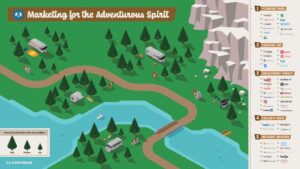HOW TO ASSEMBLE THE PERFECT ENTERPRISE MARTECH STACK FOR EFFECTIVE PROGRAMMATIC MARKETING
MarTech, otherwise known as Marketing Technology, is the term used to describe the software and tech tools that marketers leverage to plan, execute, and measure marketing campaigns. These days, marketing technology platforms like MarTech provide a crucial foundation for effective marketing and the need for this doesn’t appear to be slowing down anytime soon. With so many options available, it comes as no shock that everyone’s doing it differently because there are so many apps available to build your stack. Which ones are you using and is your stack delivering the agility and results you’re aiming for? Have you attained the gold standard? You don’t have to answer yet, just keep reading.
A quick look at MarTech history
Once upon a time, not so long ago, marketing was all about creating multi-channel campaigns that used a mix of digital and printed media. Campaign ideas were sketched on large sheets of white paper with a marker pen, then rolled out into a television schedule supported by full page press ads and a bit of radio – plus a billboard or two if the budget allowed.
When the internet arrived in the mid-1990s, enterprises started exploring its potential as a market platform. The first online marketing triumph has been attributed to Bristol-Myers-Squibb, who created an online direct-to-consumer campaign to promote a migraine medicine.
Now a significant chunk (usually the lion’s share) of any marketing campaign is online exposure, through direct and indirect channels. A thorough campaign might involve email, digital banner ads, social media posts, videos, txt messaging, web pages, blogs and personalised programmatic advertising. To achieve all this, you need a comprehensive MarTech stack that’s supported by a purpose-built CDP (Customer Data Platform).
What goes into a typical MarTech stack?
By stacking MarTech apps together, enterprises can create an integrated series of tools that allows them to build customer relationships across multiple channels. It’s a bit like a car – a collection of parts that allows you to get from point A to point B. Currently, there are more than 7500 different marketing technologies available for marketers to choose to include in their stacks.
At the 2019 MarTech Stackies, the world’s premier MarTech awards, the winning stacks show which tools enterprises use for different capabilities, as well as the strategies that marketing teams apply in organising their stacks. Some of them map MarTech tools to the customer journey, others show internal workflows and some indicate that tools are foundational ‘systems of record’. To enter the Stackies, every entrant has to create a slide that illustrates their MarTech stack. Here are a couple of winning examples:

How this stack works: Each tree represents a tool in the stack; categories are clustered as camping destinations on the map.

How this stack works: Different tools are identified as different coloured logo cube; there are four layers/stages of marketing technology; MarTech cubes are mapped into six tracks that rank their relative degree of automation.
What does this tell us about the perfect MarTech stack?
When you consider that the 2019 Stackies winners all had different mixes of tools, it’s clear that MarTech stacks must be built around the needs of the business. There’s no cookie cutter tool collection that will work for everyone. However, none of these winners would be able to achieve their own MarTech nirvana without agile, real-time data holding it all together.
Why do you need to get your own stack right?
You might not be about to enter the Stackies with your MarTech stack, but your ongoing goal must be to get your stack working effectively.
According to Avanade’s recent global research with SiteCore, MarTech stacks are failing customer experience (CX) like never before. In a study of 1,440 CIOs, CTOs, CMOs and other senior marketing and IT decision makers, 60% of the companies surveyed reported losing revenue because their digital marketing technology wasn’t working properly or because of a lack of collaboration between marketing and IT.
Anil Gupta, Executive Vice President – Program Management at Sitecore says: “IT and marketing must align to solve this challenge and leverage the right technology and a digital strategy that prioritizes a customer-centric approach, including personalized experiences and a trusted customer relationship.”
If you need help to get your MarTech stack working properly and remove many of the frustrations of digital marketing, get in touch with n3 Hub today.


